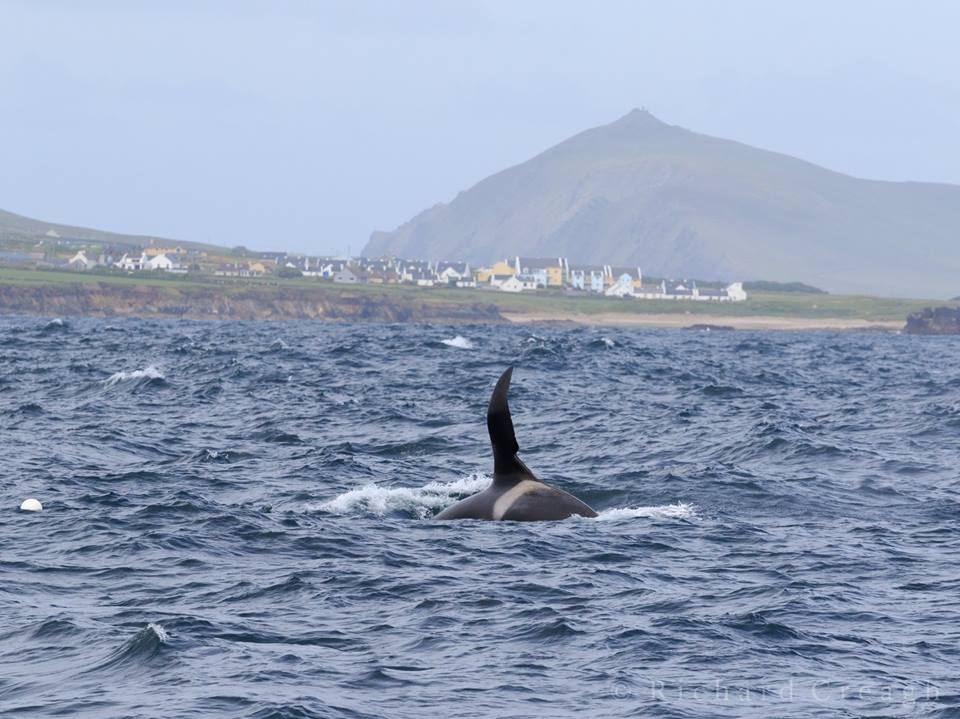Killer Whales Orcinus orca off West Kerry Ireland

Killer Whale off Clogher Head, Co Kerry, Ireland, 26.06.2016
Video
Two "strangers" off the Skellig and John Coe and his mum Nicola revisit the Blaskets
People often ask us do we see killer whales and the answer is yes, if you are fortuitous! Here is a brief history of sightings of killer whales off the West Kerry coast in recent years:
Towards the end of June 2010 we were involved as survey vessel for "Inshore boat-based Surveys for Cetaceans" for National Parks and Wildlife Service undertaken by IWDG / GMIT.
On that occasion we were very fortunate to have a very close encounter with two killer whales about 10 miles S.W. of Skellig Michael who, per photo id. [ C. Ryan; P. Whooley] were new to the North Atlantic Killer Whale ID Project. Wonderful! Click on following link for details of (unpublished) survey: https://www.npws.ie/content/publications/inshore-boat-based-surveys-cetaceans
Next encounter was on 19.07.2012 when on an evening tour with some (lucky) children on board we encountered two killer whales just east of the Wild Bank in Dingle Bay. They were later identified as male killer whale John Coe and his mother Nicola and he was first identified off Scotland in 1983 by Peter Evans. Killer whale society, just like elephant society, is matriarchal and mothers or aunts usually lead the pack, which gives the phrase " travelling with your aunt" greater nuance!
Killer whales regularly passing up the Blasket Sound
Then one morning in the following year on 12.06.2013 we got word that two killer whales had just passed up the Basket Sound from Dunmore Head and we were lucky enough to catch up with them near Clogher Head in deteriorating weather conditions with little opportunity to photo id.
There were a couple of years when we did not see any killer whales [ which of course does not mean that they were not there] and on 27.06.2016 we got word of a killer whale who had just been spotted east of Slea Head and was making his way up the Blasket Sound. We came up with him off Cloghe Head as he headed north towards Sybil Head in quite lumpy conditions [ not the whale , the sea]. It turned out to be John Coe, again, but worryingly, travelling alone this time and without his mother Nicola [ the leader of the pack, remember]
There is concern for the West Coast Community of Killer Whales that there is no juvenile recruitment and the theory is that as they are apex predators they may have accumulated concentrated amounts of toxins in their system due to a lethal combination of sea pollution and longevity which may leave them infertile / sterile. Many marine apex predators like killer whales, shark, tuna, Swordfish accumulate over time concentrated amounts of radioactive isotopes from radioactive waste from power stations dumped at sea, as they are at the top of the food chain which starts off at the bottom with the minute marine diatom organisms to which the radioactive isotopes attach, which also happens in the case of nanoparticles of degrading plastic, which forage fish ingest, and they in turn are preyed upon by bigger fish who are hunted in turn by the top predators who accumulate all the toxins ingested by the previous hierarchy of prey. In the case of breeding seabirds their eggs can be used as an indicator of pollution levels in the marine ecosystem, particularly as regards traces of mercury.
Interestingly, killer whales worldwide are speciating into two separate species [ where separated isolated populations evolve separately, as opposed to the gradual evolution of a species slowly and imperceptibly over evolutionary time scale] and the clue is in the teeth as any paleontologist worth his salt would know. "Our" killer whales have rather flat teeth for munching rather than crunching soft boned herring, sprat etc. whereas seal and other sea mammal hunting orcas [ including incredibly polar bears as prey as they are marooned at sea by the melting sea ice] have teeth with sharp serrated edges for crunching and munching through sea mammal bone, and also bigger size and coloration patches. This may be why "our" killer whales do not avail of the rich harvest of grey seals off the west coasts of Scotland and Ireland but just cruise by and pick up the occasional take away of harbour porpoises and sunfish.
"Floppy FIN" the killer whale and his mates visit Dingle Bay and surf Brandon Bay
Just when we thought that our chances of seeing killer whales again in 2016 whale watching season in Ireland were very slim, we got a call from Brandon Bay that a group of killer whales were seen about 50 meters from surfers on the 25.10.2016. A few days before we got confirmation from a fisherman that he had seen the group of killer whales, off Minard, east of Dingle Harbour a few days previously "and one of them had a floppy fin". We immediately guessed that was the killer whale known as "Floppy Fin" [ surprise] and he is a very well known [and respected] member of the Scottish West Coast Community.
So if you ask when is the best time to see killer whales in Irish waters and off the West Kerry coast, I would have to say, based on the above data, mid - June to mid - July when they seem to do the annual Tour of Ireland, but any time after that to the end of October you may have a good chance - if you are fortuitous.
















